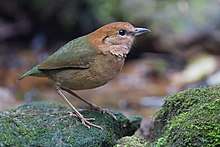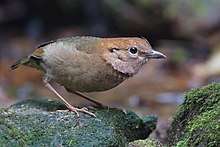Rusty-naped pitta
The rusty-naped pitta (Hydrornis oatesi) is a species of bird in the family Pittidae.
| Rusty-naped pitta | |
|---|---|
 | |
 | |
| Male and female | |
| Scientific classification | |
| Kingdom: | Animalia |
| Phylum: | Chordata |
| Class: | Aves |
| Order: | Passeriformes |
| Family: | Pittidae |
| Genus: | Hydrornis |
| Species: | H. oatesi |
| Binomial name | |
| Hydrornis oatesi Hume, 1873 | |
| Synonyms | |
| |
Taxonomy
The rusty-naped pitta was described by the amateur ornithologist Allan Octavian Hume in 1873 from specimens collected in the eastern Pegu Hills, Myanmar. Hume coined the current binomial name Hydrornis oatesi.[2] The species was subsequently placed in the genus Pitta but was then moved back to the resurrected genus Hydrornis in 2006 based on the results of a molecular phylogenetic study.[3] The genus Hydrornis had been introduced by the English zoologist Edward Blyth in 1843.[4] The specific epithet was chosen to honour the amateur ornithologist Eugene William Oates (1845-1911) who had collected the specimens.[2][5]
Four subspecies are recognised:[6]
- H. o. oatesi Hume, 1873 – from east Myanmar to northeast Laos and Thailand
- H. o. castaneiceps (Delacour & Jabouille, 1930) – southeast China to central Laos and northwest Vietnam
- H. o. bolovenensis (Delacour, 1932) – south Laos and south Vietnam
- H. o. deborah (King, BF, 1978) – central Malay Peninsula
Description
The male has a deep brown head and underparts with dull green wings. It has a well defined black stripe behind the eyes.[7] The female is duller than the male, with brownish tingeing on the wings and vague dark scaling on the lower throat.[7]
Distribution and habitat
The rusty-naped pitta is found in China, Laos, Malaysia, Myanmar, Thailand, and Vietnam. Its natural habitats are subtropical or tropical moist lowland forests and subtropical, tropical moist montane forests and bamboo forests. It is typically found above 800 m (2,600 ft).[7]
References
- BirdLife International (2016). "Hydrornis oatesi". IUCN Red List of Threatened Species. 2016: e.T22698608A93692066. doi:10.2305/IUCN.UK.2016-3.RLTS.T22698608A93692066.en.CS1 maint: uses authors parameter (link)
- Hume, A.O. (1873). "Novelties: Hydrornis oatesi". Stray Feathers. 1: 477–478.
- Irestedt, M.; Ohlson, J.I.; Zuccon, D.; Källersjö, M.; Ericson, P.G.P. (2006). "Nuclear DNA from old collections of avian study skins reveals the evolutionary history of the Old World suboscines (Aves: Passeriformes)" (PDF). Zoologica Scripta. 35: 567–580. doi:10.1111/j.1463-6409.2006.00249.x.
- Blyth, Edward. "Mr Blyth's report for December meeting, 1842, with Addenda subsequently appended". Journal of the Asiatic Society of Bengal. 12 (143): 925-1010 [960].
- Jobling, J.A. (2018). del Hoyo, J.; Elliott, A.; Sargatal, J.; Christie, D.A.; de Juana, E. (eds.). "Key to Scientific Names in Ornithology". Handbook of the Birds of the World Alive. Lynx Edicions. Retrieved 15 January 2019.
- Gill, Frank; Donsker, David, eds. (2019). "NZ wrens, broadbills, pittas". World Bird List Version 8.2. International Ornithologists' Union. Retrieved 15 January 2019.
- Robson, Craig. Birds of Thailand. p. 150. ISBN 978-0691007014.
